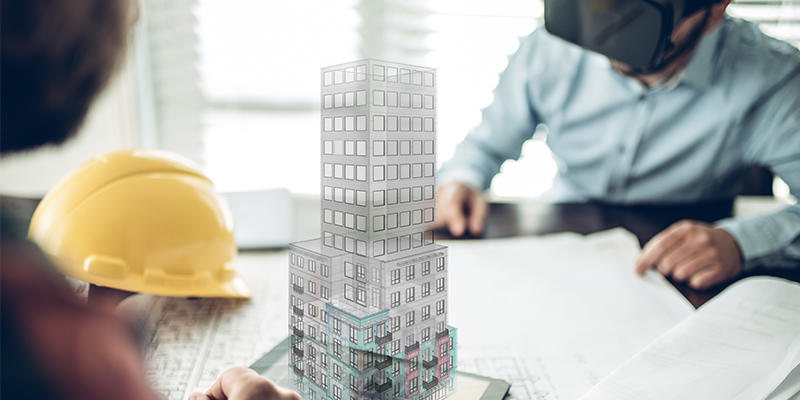Real estate development is an ever evolving and, at times, volatile business. Advanced technology can help to mitigate that volatility and improve processes in the construction and real estate industry. Building information modeling, or BIM, is one of the most powerful tools developers can use to reduce risk and ensure the profitability of their investments. BIM not only allows for better planning and project design, but also facilitates collaboration, communication, efficiency and ongoing asset management.
Building Information Modeling (BIM) in Real Estate
What is BIM?
Building information modeling (BIM) is a type of 3D modeling software that can be used to facilitate collaboration on every aspect of a building project, from design to construction to ongoing maintenance. Unlike traditional 3D computer models, BIM images contain vast amounts of data. Each component of a BIM model contains information about costs, spatial relationships, materials and more. BIM can also simulate design changes and identify potential problems before they become reality. Through the power of cloud-based computing, BIM models can be accessed from virtually anywhere in real time, allowing for better collaboration and information sharing among project stakeholders.
The Shift in Real Estate Investment Landscape with BIM
While BIM has been widely adopted in the construction industry, real estate developers and investors have begun to realize the benefits of BIM as well. BIM has made it possible for real estate investors to make more informed decisions about their investments and to mitigate risks along the way.
BIM also supports ongoing asset management activities by providing a centralized repository of building information that can be leveraged for maintenance, renovations and future planning. This comprehensive dataset enables investors to make data-driven decisions throughout the property lifecycle – long after the build is complete.
Risk Mitigation Through Enhanced Project Visualization and Planning
Building Information Modeling (BIM) mitigates risks and uncertainties in construction and real estate projects in a few different ways.
Role of BIM in Reducing Uncertainties
The level of visualization and planning made possible by BIM is unlike anything the real estate industry has seen before. Rather than merely looking at a digital rendering of the space, stakeholders can view all kinds of data associated with various aspects of the project, from the building facade to the heating and cooling systems. This level of detailed visualization complete with relevant data reduces the likelihood of surprises and uncertainty for investors.
Unexpected design flaws or clashes can hinder a construction project’s progress. Redesigns can be expensive and time-consuming. BIM allows investors to assess and mitigate these kinds of risks more effectively by identifying potential issues such as clashes between building systems, structural weaknesses, or compliance issues before construction begins. This proactive approach helps minimize the likelihood of costly setbacks or legal disputes, thus safeguarding the investment.
Improving ROI with Efficient Resource Management and Cost Savings
BIM can help to improve real estate building and investment ROI by controlling costs and ensuring efficient use of resources. BIM allows for more accurate cost estimates early in the project lifecycle by providing detailed digital visual representations of the project. This accuracy helps in minimizing unexpected costs and expensive delays. BIM’s precise models and simulations also allow developers and construction teams to optimize the allocation of resources and minimize waste.
Long Term Financial Benefits and ROI Enhancement with BIM
By identifying design conflicts and issues before construction begins, BIM helps in avoiding delays and reducing the need for changes during construction, which can be costly and time-consuming. This efficiency not only saves money but can also lead to earlier project completion and revenue generation.
BIM extends its benefits beyond construction into the operation and maintenance phase of a building. Facility managers can use BIM models for space management, energy analysis, and maintenance scheduling, leading to significant cost savings over the building’s lifecycle.
BIM enables the design of more energy-efficient buildings by simulating energy consumption and analyzing different scenarios. Energy-efficient buildings can result in lower operating costs and can also attract tenants and buyers willing to pay a premium for sustainable features, enhancing the property’s value.
BIM Facilitating Better Collaboration and Future Trends
Enhancing Stakeholder Collaboration and Communication
One of the most significant benefits of BIM technology is its ability to facilitate seamless collaboration and communication among stakeholders. Architects, engineers, construction site managers, investors and clients can all access the most up-to-date information in real time, ensuring everyone remains on the same page. This immediacy improves decision-making and reduces delays in communication.
BIM’s advanced visualization tools also help stakeholders from nontechnical backgrounds, such as investors and clients, to understand the project details more intuitively. This enhances communication and ensures that expectations are aligned.
Future Trends: BIM and Its Evolving Role in Real Estate Investment
The integration of BIM with other technologies like artificial intelligence (AI), virtual reality (VR), and augmented reality (AR) is set to enhance its capabilities further. For instance, AI can automate routine tasks and analyze BIM data to identify optimization opportunities, VR and AR can provide immersive experiences for better design understanding and client engagement.
As the focus on sustainable and green building practices increases, BIM is expected to play a crucial role in facilitating the design and construction of energy-efficient buildings. Through simulation and analysis, BIM can help in optimizing materials usage, energy consumption, and overall environmental impact. Likewise, as governments and international bodies introduce stricter regulations for building efficiency and safety, BIM can help ensure compliance through detailed documentation and adherence to standards.
BIM has revolutionized the real estate investment business by improving decision-making, reducing costs, enhancing collaboration, mitigating risks, promoting sustainability and supporting efficient asset management practices. As technology continues to evolve, its impact on the industry is expected to grow even further, driving greater efficiency, innovation, and value creation in real estate investments.








